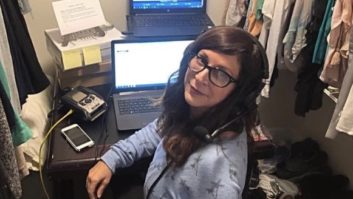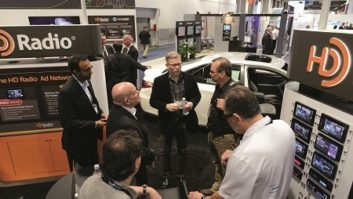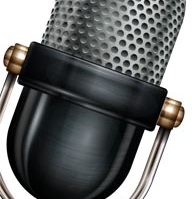Some broadcasters are excited about the idea of using drones to check towers or improve their news and traffic coverage. AM’s future is a big concern right now, as are Nielsen Portable People Meter encoding and FCC plans to close many of its field offices. Podcasting is seen by PDs, networks and their distributers no longer as an outlier but as a potential money-maker.
These are some of the radio themes evident at the recent NAB Show. Here’s a roundup; find more coverage on AM’s future. More topics, including HD Radio, NextRadio, FM chips and the connected car, will be covered in the next issue.

“We can choose to sit idle, or choose” to act, said NAB EVP/CTO Sam Matheny in his first Broadcast Engineering Conference keynote.
Credit: ©NAB/Robb Cohen PhotographyMATHENY: ENGINEERS MATTER MORE THAN EVER
Broadcasting is at a crossroads and must be guided by change, choice and principles, according to NAB Executive Vice President/Chief Technology Officer Sam Matheny.
“Most of the challenges our industry faces are driven by new technologies. This means the role of the broadcast engineer is more important than ever,” he told attendees in his first Broadcast Engineering Conference keynote. “We must get comfortable with disruptive ideas.”
“It used to be when a broadcast engineer was asked about ‘IOT,’ he would most likely answer with something about the way inductive output tubes impact the RF amplification; a discussion of klystrons and efficiency gains would soon ensue,” Matheny said.
“But today, if asked about IOT, that same engineer may just as likely — perhaps even more likely — start talking about the ‘Internet Of Things’ and a TV everywhere or streaming radio strategy.”
IP connectivity is expanding, and today’s radio and TV engineers must understand that the merger of IT and engineering functions is something “we all must effectively manage.”
“There are no facts about the future. It is ours to create. We can choose to sit idle, or choose” to act, he said. Connectivity will increase; data costs will come down; consumers will be more demanding; and data will be more important, he said.
WHEELER: PIRATE ENFORCEMENT WON’T SLACKEN
Chairman Tom Wheeler said an FCC plan to close to close two-thirds of Enforcement Bureau field offices and cut the number of field agents by half does not mean the commission is backing away from its responsibilities in interference protection.
The proposal would leave the agency with eight field offices and 33 field agents. But pirate enforcement won’t diminish, according to Wheeler, who acknowledged broadcasters’ apprehension over the closure plan.
NAB and the agency are in talks about the proposal. “We want to work with you,” he told broadcasters at the convention.
Before the show, NAB VP Spectrum Policy Bob Weller — who began his career as a radio inspector in the FCC’s San Francisco field office — blogged that the agency should reverse course.
Wheeler, without getting into specifics, pledged to put more field agents on the ground in Miami and New York, both hotbeds of pirate activity; and he reiterated what Enforcement Bureau Chief Travis LeBlanc said: Every agent will be an electrical engineer.
“This is a situation of new realities demanding a reassessment of how we do business,” Wheeler said. Keeping all field offices open costs some $10 million a year, two to four times the cost of operations under the more centralized plan. He called overhead costs “ridiculously high.”
On the day he spoke, the FCC fined a New York pirate $20,000.
In response to a question from Radio World after the speech, NAB President/CEO Gordon Smith took a pragmatic approach. He said he understands broadcasters have concerns over how the commission handles enforcement, but believes the agency should be given an opportunity to demonstrate how it can work more effectively.
“It’s not a hill that the NAB is going to” climb, Smith said. If the chairman “thinks this is a more reasonable approach,” he’s fine with it. “I just care about the result.”
Some members of Congress, meanwhile, are taking a closer look.
Democratic House Commerce Committee staffer Margaret McCarthy participated in a panel moderated by former Commissioner Robert McDowell. She said the FCC’s “budget has been essentially flatlined” and that it’s trying to do more with less. “Our Democratic members have said we can’t really punish the agency” when Congress isn’t providing more resources.
However, GOP members are paying close attention to the field closure plan. “We care a lot about what’s going on in the field,” said House Commerce Committee Republican staffer Dave Redl. He said that House Telecommunications and Technology Subcommittee Chairman Rep. Greg Walden (R-Ore.), a former radio station owner, “has said the FCC should focus on its core mission — to prevent interference.”
In late April, four GOP House lawmakers said they were giving the FCC until May 7 to turn over material related to the proposal. They are Walden, Committee Chair Fred Upton (R-Mich.), Oversight and Investigations Subcommittee Chairman Tim Murphy (R-Pa.) and Rep. Mike Pompeo (R-Kan.) They asked for all material related to the closure plan and told the FCC that the proposal to reduce its geographic footprint “appears to ignore the impact this might have on the commission’s public interest goal.”
In a subsequent letter, Walden and Ander Crenshaw, (R-Fla.) chair of the Financial Services and General Government Appropriations Subcommittee, asked for material related to how the “Tiger Teams” would be able to respond to interference concerns within 24 hours and what regions in the country experience the highest interference rates.

Enforcement Bureau Chief Travis LeBlanc is interviewed by predecessor David Solomon.
Credit: Photo by Leslie StimsonLEBLANC: FIELD OFFICE STRUCTURE OLD, COSTLY
New Enforcement Bureau Chief Travis LeBlanc says the office closure plan reflects an effort to modernize the bureau and use its increasingly scarce resources wisely.
The structure of the field offices is 20 years old, too costly and not effectively focused on the commission’s current or future needs, he and Wheeler believe.
“We’re beginning to think about where we need to direct our scarce resources to reach the maximum impact,” he said. This means “doing less of some work and more of other work.” LeBlanc was interviewed by moderator David Solomon, himself a former Enforcement Bureau chief and now a partner at Wilkinson Barker Knauer.
LeBlanc said that when he arrived at the bureau a year ago, morale in the field was low and no one was being replaced in the field offices because of the agency’s “flatlined budget.” He said that “over 50 percent” of the 63 field agents are eligible for retirement.
Under the proposal, broadcasters — now accustomed to working with regional field offices — would communicate instead to an FCC person in Washington. That position would oversee the field directors and parcel out the work, and it would be a full-time position, not one duty among several handled by a deputy chief as is the case now, according to LeBlanc.
He said that the agency will continue to “assess if we need to restructure” the plan as it gets implemented. “That’s certainly on the table.” He said the bureau is “actively engaged with NAB” on this proposal.
Paul Tinkle is president of radio group Thunderbolt Broadcasting; its stations serve small markets in western Tennessee and Kentucky. He asked LeBlanc to reconsider. He envisioned broadcasters having to call Washington to complain about competing stations drifting off-frequency or exceeding licensed power.
In smaller markets, Tinkle said, field offices are the face of the commission. “When that FCC inspector comes in, he’s really the voice of God.”
He also pressed LeBlanc to give field agents new measurement tools. LeBlanc assured him part of the proposal is to modernize equipment.
NO PIRATES IS THE GOAL
The agency plans to change its approach to pirate radio, according to LeBlanc.
Broadcasters are worried that interference from pirates will become rampant in the wake of the FCC cutbacks; some told Radio World the commission seems to be backing away from spectrum enforcement, reacting to the proposal with words like “unconscionable” and “it sickens me.”
LeBlanc likened fighting pirates to playing Whac-A-Mole; the agency gets a pirate off the air only to see it turn up again six months later.
“We need to think about, when we take action, that [the pirate] is actually off the air and things to prevent pirates ever getting on the air. We want to get to a world where there are no pirates on the airwaves,” said LeBlanc. He said he’ll work with NAB and broadcasters on “policy options that remove incentives” for pirates.
O’RIELLY FLOATS ANTI-PIRATE SCHEME
FCC Commissioner Michael O’Rielly acknowledged that the agency’s enforcement resources are stretched. “We need to consider other ways to remove the scourge that is pirate radio.”
The GOP commissioner discussed his ideas during the show, saying that pirate radio “causes unacceptable economic harm to legitimate and licensed American broadcasters by stealing listeners.”
He cited a legal approach that’s been used to combat email spam, saying it may work for broadcasters too. The “CAN-SPAM Act of 2003” essentially authorizes Internet service providers to seek out “bad actors” for a host of illegal activity and recoup their losses. (The acronym stands for “Controlling the Assault of Non-Solicited Pornography and Marketing.”)
“If we can narrowly permit a limited and targeted private right of action here, to be used only by broadcasters, it could provide a valuable tool to tackle a persistent problem in some radio markets.”
This framework serves as a good model to provide more options outside of the FCC process for deterring and eliminating pirate radio, according to O’Rielly.
Such a rule change may need congressional approval, and he emphasized that he’s not suggesting consumers be allowed to file lawsuits against pirate stations.
O’Rielly says his proposal is not related to the agency plan to reduce its field offices; he has not taken a position on that issue.
Queried by Radio World about the commissioner’s comments proposal, several broadcast engineers expressed concern about their stations going after pirates directly, noting that illegal operators often set up their gear in bad neighborhoods. “We’re not the police. Nor are our attorneys,” said one head of engineering of a radio group.

Is this the “golden age of podcasting”? Podcast One Founder/CEO Norm Pattiz raised the question at the Radio and Internet Newsletter conference.
Credit: Photo by Leslie StimsonFEDS SEE BROADCAST ROLE IN NEXT-GEN EAS
Federal regulators emphasized that broadcasters definitely have a role to play in the future of EAS. Representatives of the FCC and FEMA also discussed how next-generation alerting could benefit alert originators, emergency managers and broadcasters; and they talked about the advantages of integrating IP-enabled technologies into the broadcast platform.
FCC Public Safety & Homeland Security Bureau Chief David Simpson said the federal vision for the future of emergency alerting “will only enhance the role broadcasters will play. First responders get a lot of well-deserved credit, but broadcasters are first informers.”
“We envision a public communications model in which EAS works hand-in-glove with other services,” like 911, for example, said Simpson. Using metadata, alerts can be geo-targeted, and devices can decide if they pertain to the user or not.
FEMA is dedicated to maintaining the public warning system, Assistant Administrator of the National Continuity Program Damon Penn said. Even though wireless alerts are now receiving a lot of press and attention, he reassured broadcasters that “we’re committed to EAS.”
FEMA is “looking to leverage HD Radio, hybrid radio and NextRadio” and even the FM chip in EAS, said Penn.
Yet the feds also are looking to broadcasters to tell them what they think broadcasting will look like 10 to even 30 years from now to plan for the future EAS.
FEMA has been prepping for another national EAS test. Asked about the status of a report and order regarding that test, Simpson said it’s on the eighth floor of FCC headquarters for commissioners’ review. Though he couldn’t predict when it would be complete, he looked forward to “being able to announce something soon.”
PODCASTING COMES OF AGE
Is this the “golden age” of podcasting? Podcast One Founder/CEO Norm Pattiz asked that question of a panel at the Radio and Internet Newsletter Conference.
Andy Bowers, chief content officer for Slate/Panoply Media, said when he began podcasting, new vistas immediately opened. “Look at all the things you can do that you can’t do on radio. There’s no clock, and I can do it from my desk,” said Bowers, a former NPR correspondent.
“We’re making it up as we go along,” said Bowers. “Podcasting is the way of the future.”
Pattiz said one of the reasons he got into podcasting after 35 years in radio is that podcast listeners are P1 listeners “and now you’ve got social media to promote to them.”
Pattiz asked Tom Leykis how podcasting is different than radio. Leykis said that in radio “you spend 77 percent of your time chasing P2s and P3s, the people who don’t love you.” In contrast, in podcasting, “the P1 is everything,” said Leykis.
“They pay your bills, show up at events and tweet about you,” he continued. “When I worked at a station, the listeners found commercials to be an intrusion. In podcasting, the listener understands if they want their favorite programming, it’s got to have advertising.”
Podcasters are starting to become bigger players in the media ecosystem, said Pattiz. “We sink or swim together.”
Indeed, “Serial,” the podcast about a 1999 murder in Baltimore, was the first podcast to win a George Foster Peabody Award, announced shortly after the convention.
Did you attend the NAB Show? What were your takeaways? Email[email protected]with Letter to the Editor in the subject field.











